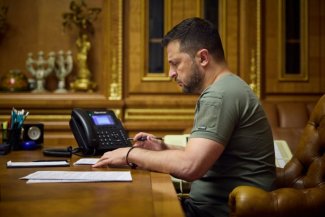More US military support packages for Ukraine. Day 561 of the war

During the period of 5–8 September there was no significant change in the position of the warring parties. Armed clashes are still mainly focused on the vicinity of the villages of Novoprokopivka and Verbove in the Zaporizhzhia oblast, where Ukrainian assault troops are slowly moving forward and capturing successive points of Russian resistance. Fighting is underway around the hills between these towns, which is a key position in the invaders’ defensive system. At the same time, it can be seen that the Ukrainians, out of fear that their troops may be outflanked as they try to drive a wedge southwards, are manoeuvring and launching attacks along the enemy’s defence line in the western and eastern directions. In order to shore up their right wing they must capture Novoprokopivka, as advancing south will otherwise be difficult and risky. On the section of the Zaporizhzhia front further east, near the Mokri Yaly river, there is an operational pause. According to unconfirmed reports, a few days ago the Ukrainians increased their activities (intensive artillery shelling and limited assault group activities) in the vicinity of the villages of Novodonetske, Novomayorske and Shevchenko, at the junction of the Russian 36th and 29th Armies.
Heavy fighting continues in the Bakhmut area, especially south of the town along the railway line. In recent days, Ukrainian troops have made little progress near Andriivka and Klishchiivka; they have only seized part of the ruins of the latter village. Clashes are also continuing near Kupyansk and along the west bank of the Zherebets river, where the Russians have been trying unsuccessfully to break through the Ukrainian defences.
On the night of 5–6 September, the invaders attacked Ukraine with one Iskander-M ballistic missile, seven Kh-101/Kh-555/Kh-55 cruise missiles and 25 Shahed 136/131 drones. The Ukrainian Air Force Command declared that all the missiles and 15 of the drones had been shot down. Once again, the main targets of the attacks were the Danube ports of Kilia, Izmail and Reni; parts of the handling & administrative infrastructure and warehouses were destroyed as a result of the drone strikes. During the day the invaders attacked the city of Zaporizhzhia; Ukraine has not provided any specific reports on the type of missiles used or the facilities hit. On 6 September, a market in the town of Kostiantynivka in Donetsk oblast was attacked, killing 16 people and wounding 33. Initially, President Volodymyr Zelenski said that Russian artillery shelling had been the cause of the tragedy. The following day, however, a spokeswoman for Donetsk oblast police ruled out the use of artillery, and stated that an investigation was underway to determine the type of weaponry used. On the nights of 6–7 and 7–8 September, the Russians launched further massed attacks with drones on the Danube ports in Odesa oblast. Ukrainian anti-aircraft defences claimed to have neutralised 25 of the 33 Shahed 136 drones and 16 of the 20 Shahed 131s which were used. Elements of the port and storage infrastructure were damaged. On the morning of 8 September, the Russians launched missile attacks on Zaporizhzhia, Sumy and Kryvyi Rih; civilian infrastructure was damaged and at least one person was killed.
On 6 September, Ukraine’s new defence minister Rustem Umierov reported that budget expenditures amount to more than 3 trillion hryvnia (about $81 billion) per year, of which more than 1.6 trillion hryvnia (about $43 billion) are being used to finance the security and defence sector. According to Umierov, there is a shortfall of more than 1.5 trillion hryvnia (about $41 billion) in the state coffers to fully cover war needs. He also stated that more than one million people are currently involved in the country’s security and defence sector, of which more than 800,000 are in the Armed Forces, and by the end of the year an additional 250 billion hryvnia (almost $7 billion) will be needed for their salaries. He has prioritised the holding of an internal audit; at the same time, a digital system for registering conscripts will be launched in order to curb corruption. Umierov also announced that the plan for the transformation of Ukraine’s defence system would be developed in accordance with NATO standards, and that the capabilities of the defence industry would be increased. In turn, he stated that in his opinion the preparation of the necessary infrastructure for the operation of F-16 fighter jets is one of the most important projects to be implemented by his ministry.
On 5 September Fedir Venislavsky, the representative of the president in the Ukrainian parliament, insisted that there would be no mass extraditions of men evading military service back to Ukraine. He stressed that criminal liability is individual in nature, so the extradition procedure can only be triggered after evidence is presented that a person is hiding from the law enforcement authorities. State Border Service spokesman Andriy Demchenko said that since 24 February last year more than 20,000 people have been detained trying to cross the border illegally. Between 20 and 30 such cases are recorded daily, with the largest number of cases occurring on the borders with Romania and Moldova. On 7 September, the Ukrainian Border Service reported that 1800 people have been refused permission to cross the border since January this year, when a ban on government officials leaving the country was introduced.
Ukrainian military intelligence spokesman Andriy Yusov confirmed on 6 September that formations composed of Russians fighting on the Ukrainian side (the Freedom of Russia Legion and the Russian Volunteer Corps, RKO) have continued carrying out combat tasks in Russian border areas, and have handed over the prisoners they captured to the Ukrainian side. That day, the RKO reported that it had launched another raid into Russian territory, where it fought a battle with FSB border guards; they claimed to have wounded around 10 officers and killed one.
A day later, Ukraine’s Prosecutor General Andrei Kostin stated that according to the latest estimates, around 90% of Ukrainian prisoners of war had been subjected to torture, rape, threats of sexual violence or other forms of ill-treatment. So far, 156 Russian military officers and representatives of the ‘occupation authorities’ suspected of using violence against Ukrainian soldiers have been identified. Charges have been filed in court against 114 individuals.
On 6 September, the Russian state’s legal information website posted a proposal submitted by the defence ministry to amend the ‘Military Registration Regulations’. This would remove the paragraph stating that prisoners are not subject to registration; instead, the concept of ‘special military registration’ will be introduced for conscripts and persons fit for military service who are in penal colonies, prisons and correctional institutions. The Federal Prison Service will be responsible for keeping the records. According to official statistics, as of 1 January 2023, there were 433,000 people in places of detention, predominantly men (there were 28,300 women in prisons as of 2022).
On 8 September, the independent news channel Bielaruskiy Hayun, which monitors troop movements in Belarus, reported that most of the Russian air force group which had been stationed there (four Mi-8 helicopters, seven Mi-24 attack helicopters and nine Su-34 and Su-30SM fighters) had returned to Russia as recently as August. One Russian Su-25 attack aircraft remained at Lida airport; it was also stated that more than half of the field camp in the village of Tsel, where the troops of the Wagner Group were stationed, had now been dismantled. Of the 292 tents set up at the end of July, only 130 are still standing.
The German Chancellery reported on 5 September that Germany had sent Kyiv 32 Zetos trucks, 8.64 million rounds of small-arms ammunition, 26,880 40-mm grenades, one Biber bridge-laying tank, four all-terrain vehicles, four HX81 trucks & four trailers for them, and 10,080 35-mm rounds for the Gepard air defence guns; these latter have come off the Rheinmetall company’s new production line. On the same day the German arms company Diehl Defence, whose products include the IRIS-T SL family of air defence systems, announced that two IRIS-T SLM systems delivered to Ukraine had shot down a total of 110 Russian targets and demonstrated 100 per cent effectiveness. Diehl also announced an increase in production; as of 2024 they will produce eight systems and 500 missiles annually.
On 6 September, the US announced another military support package for Kyiv worth $175 million. It will include spare parts for air defence systems, ammunition for HIMARS launchers, 155-mm and 105-mm artillery shells and 81-mm mortars with ammunition, anti-tank rounds made from depleted uranium for Abrams tanks, TOW and Javelin anti-tank guided missiles and AT-4 grenade launchers, more than 3 million rounds of small arms ammunition, navigation systems for aircraft (most likely F-16s), secure communications systems, demolitions munitions for obstacle clearance (most likely M58 MICLIC extended charges) and spare parts. All the support will be provided from the resources of the US Department of Defense within the framework of the Presidential Drawdown Authority (PDA).
The following day, US Secretary of State Antony Blinken announced while visiting Kyiv that there will be an additional $600 million package of US military support. This includes equipment for the maintenance and integration of Ukraine’s air defence systems, missiles for HIMARS launchers, 105-mm artillery munitions, electronic warfare (EW) and counter-electronic warfare equipment, explosives for clearing obstacles and mines, training support and repair services. All of the assistance comes from the Ukraine Security Assistance Initiative (USAI), and will therefore be procured by the US Department of Defence from the defence industry.
Commentary
- Tank ammunition made from depleted uranium will not be a novelty on the Ukrainian battlefield: the UK has been supplying it for its Challenger 2 tanks since 25 March this year. Although anti-tank ammunition made from other materials (such as the KEW family of rounds) is produced in the US, the US Armed Forces themselves do not use it. Thus, only depleted uranium ammunition, which has greater armour-piercing capabilities than its classical (tungsten) counterparts, can be supplied under the PDA.
- The Russian defence ministry’s postulated changes to the law on the registration of those fit for military service held in prisons will mean that prisoners will eventually be included in the stock of mobilisation reserves. The way to such a solution was opened by a statutory amendment signed by Vladimir Putin in June allowing prisoners to sign contracts with the armed forces. The creation of the register will allow inmates who have military experience but who have not yet expressed an interest in participating in the war with Ukraine to be drafted into the army.





